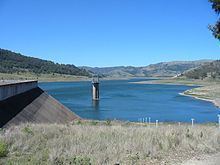Status Operational Construction cost A£30 million Length 16 km Surface area 15.4 km² Construction began August 1980 | Opening date June 1983 (1983-06) Height 67 m Catchment area 233 km² Create Lake Saint Clair Spillway 1 | |
 | ||
Purpose Flood mitigation, irrigation, water supply and conservation | ||
Glennies Creek Dam is a minor ungated concrete faced curved earth and rockfill embankment dam with an uncontrolled rock cut spillway across the Glennies Creek, upstream of Singleton, in the Hunter region of New South Wales, Australia. The dam's purpose includes flood mitigation, irrigation, water supply and conservation. The impounded reservoir is called Lake Saint Clair.
Contents
Glennies Creek Dam was created through enabling legislation enacted through the passage of the Glennies Creek Dam, 1979 (NSW). The Act appropriated A£30 million as the estimated cost of construction of the dam.
Location and features
Commenced in August 1980 and completed in June 1983, the Glennies Creek Dam is a minor dam on Glennies Creek, a tributary of the Hunter River, located approximately 25 kilometres (16 mi) north of Singleton and 39 kilometres (24 mi) upstream of the confluence of Glennies Creek with the Hunter River. The dam was built by Citra Constructions Limited on behalf of the NSW Department of Land and Water Conservation and the NSW Department of Water Resources to supply water for the town of Singleton, as well as irrigation, flood mitigation, and for coal mining.
The dam wall height is 67 metres (220 ft) and the arch crest is 535 metres (1,755 ft) long. The maximum water depth is 56 metres (184 ft) and at 100% capacity the dam wall holds back 283,000 megalitres (10,000×10^6 cu ft) of water at 186 metres (610 ft) AHD. The surface area of Lake Saint Clair is 1,540 hectares (3,800 acres) and the catchment area is 233 square kilometres (90 sq mi). The uncontrolled rockcut spillway is capable of discharging 637 cubic metres per second (22,500 cu ft/s). A 60 metres (200 ft) high control tower with variable level inlets allows for the control of the quality and temperature of water released from the dam. Glennies Creek Dam is operated in conjunction with Glenbawn Dam. The two dams supply water requirements along 40 kilometres (25 mi) of the Hunter River from Glenbawn to the tidal reaches near Maitland.
Glennies Creek Dam spillway is an unlined cutting in welded ash flow tuff which supplied the entire rock fill requirement for the construction of the dam embankment. The spillway excavation was designed to be located entirely in welded tuff and not to encroach on either the underlying non-welded tuff or the overlying sandstone, both of these rock types being much inferior to the welded tuff as a rock fill construction material.
The Glennies Creek and the Glennies Creek Dam are both named after James Glennie, a former naval captain who was granted creek frontage land near the Hunter River junction in 1824.
Recreation
The dam is a popular location for swimming, boating, sailing, water skiing and fishing.
